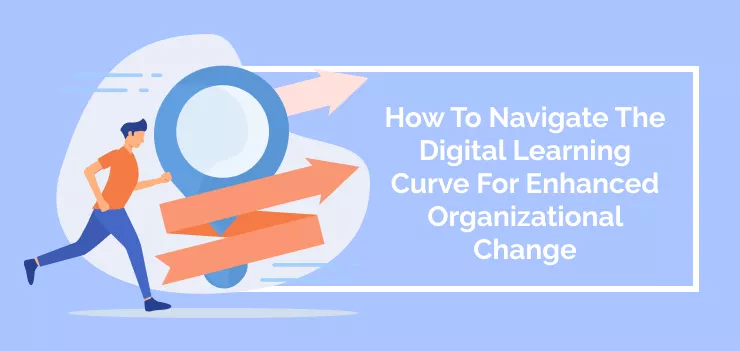
Organizational change can trigger various employee reactions when major structural shifts occur and normalized processes, technology, and tools are replaced with unfamiliar ones. This can often spark internal resistance to change, resulting in low employee performance and decreased productivity if not remedied.
Resistance to change is just one of several phases experienced by employees navigating the learning curve. Business leaders understand that resistance to change can become detrimental to the bottom line if change management parameters aren’t thoroughly established.
This includes ascertaining the impact of change and the degree of influence (i.e., is it a gradual or incremental change?). It also includes launching learning curve models to categorically monitor employee progress during transitional periods.
The adoption of learning curve models has risen as part of a wider organizational effort to streamline corporate change initiatives with better, more efficient change management processes.
WalkMe statistics on change management and unsuccessful transitions reveal that “47% of organizations that integrate change management are more likely to meet their objectives than the other 30% that did not incorporate it.”
In this article, we will explain what the learning curve is and how to use it to implement organizational change effectively. We’ll share key tips for change advocates and explore the pros and cons—but more specifically, we’ll discuss how the onset of rapid digital transformation across industries has given rise to the digital learning curve.
What is the Learning Curve Theory?
The learning curve was theorized by German psychologist Herman Ebbinghaus in the late 19th century and represents a set of principles that can be applied to different learning tasks, including knowledge acquisition, problem-solving, and memorization.
The learning curve is also known as the experience curve, the cost curve, the efficiency curve, or the productivity curve. Irrespective of the industry, the learning curve theory presents an equal opportunity to learn and excel in any field.
Learning curves are a way to measure the relationship between a person’s performance on an activity and the time and effort required for them to finish. Curve trends show that as new learners become more skilled in a task, their proficiency increases while the number of attempts decreases.
From a business perspective, learning curve models are a methodology for generating higher productivity at a lower cost by reducing the employee skill gap with continuous practice and training. This also helps employees adapt to digital transformation in an ever-changing business environment.
The learning curve presents a clear-cut cost and benefit analysis, providing a comprehensive understanding of all aspects of the organization.
The Learning Curve formula: Y = aXb
Y = The average length of time calculated over an observed period
a = Initial task completion time
X = The total number of attempts accomplished
b = slope of the function
CHART * Can the GD team recreate this image showing the correlation between a learner’s performance on a task or activity and the number of attempts or time required to complete the activity.
A typical learning curve inclines rapidly as employees learn the basics of a new technology, concept, or process. After reaching a peak performance level, it flattens out, indicating that the employee has mastered the skill.
Learning curves may also dip as employees encounter new challenges and must adjust their skills to compensate. As such, change leaders must regularly evaluate the impact of new or updated processes and procedures to smooth out any dips in productivity.
The Ebbinghaus’ Forgetting Curve
Ebbinghaus published the Forgetting Curve in 1885, which suggests that individuals forget most of what they have learned within 24 hours. The Forgetting Curve describes how individuals recall information over a period of time, with short-term memory being lost quickly and long-term memory taking more time to decline.
To resolve this, learning strategies such as spaced repetition can help employees retain knowledge in the long term, while frequent review and testing are effective for short-term memory recall.
The Forgetting Curve theory should be considered within wider learning curve models as short-term memory loss can significantly impact the rate of improvement and the employee’s ability to retain knowledge. Managers and change advocates should plan for the repetition of core tasks and regularly review progress to ensure that employees are maintaining the newly acquired skills.
What Is The Digital Learning Curve?
The digital learning curve is an adaptation of the Learning Curve theory—except for the digital age. In this context, curve models can be deployed to measure how quickly employees can learn new digital technologies, such as software and devices, and how quickly they can apply that knowledge to boost productivity and digital proficiency.
In their Nature of the Digital Skills Gap survey, AND Digital found that “81% of bosses in the United Kingdom say the digital skills gap is hurting business.”
Digital learning curve models can facilitate the creation of digital programs and initiatives to ensure users receive the most effective and efficient training. Curve model analytics can create effective onboarding strategies, bleeding-edge digital learning experiences, and enhanced user testing processes.
Moreover, with consultant firm Prophet reporting that “51% of digital transformation efforts are fueled by market pressure and growth opportunities,” digital curve models emerge as an ideal tool for measuring the digital adoption rate among consumers and businesses and identifying opportunities to improve the user experience.
Navigating the Digital Learning Curve
Transformations are underway across global industries, most of which are digital transformations (DX). To maintain marketplace perpetuity and outmaneuver the competition, change initiatives consisting of rapid digital adoption will be essential for long-term organizational success.
However, digital transformation strategies remain in the slow lane despite technology advancing rapidly and revolutionizing our business.
Outdated strategies utilizing new technologies can be detrimental to the value of a business. The strategies that once proved successful may no longer be effective; organizations must continually evolve and strategize methods for creating value in the digital age.
Co-Founder of The Digital Value Institute, Thornton May, highlights the lack of organizational vision and guidance in the face of an increasingly digitally-driven world, stating: “In our contentious times, the ONE Thing that EVERYONE can agree upon is that EVERY Organization, EVERY Executive, EVERY Individual, and EVERY Object is on a digital journey. Sadly, most have no map, no guide, and bad shoes.”
The Elisabeth Kübler Ross Change Curve
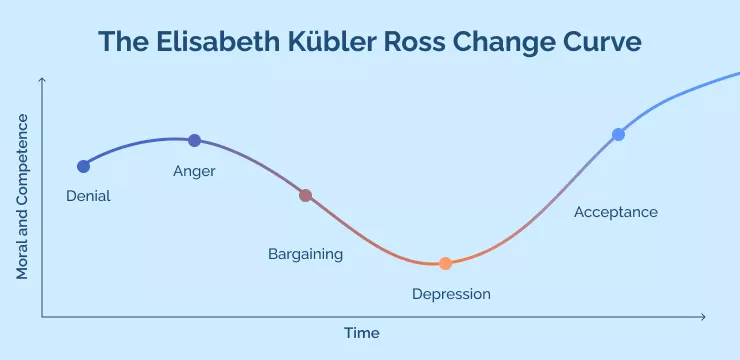
Swiss-American Psychiatrist Elisabeth Kübler Ross created a similar learning curve framework in 1969 – the Kübler Ross Change Curve Model – which outlines the curve’s five stages of change: denial, anger, bargaining, depression, and acceptance.
The five stages of the Elisabeth Kübler Ross Change Curve can be broken down into the following:
- Denial – This stage represents the initial reaction to change and is characterized by disbelief, confusion, and shock. Additionally, employees may experience feelings of helplessness and a sense of loss.
- Anger – Employees may become frustrated at this stage and struggle to cope with the changes, resulting in emotional outbursts and resistance. Employees may be more likely to question leadership decisions and become distracted from the task.
- Bargaining – During this stage, employees may attempt to negotiate with supervisors to avoid the changes or make them seem less complicated. Employees may also make compromises to mitigate the negative impact of change.
- Depression – At this stage, individuals may experience feeling overwhelmed and powerless in the face of change. This is an emotionally draining stage where employees struggle to cope with the changes and may lack the motivation to progress.
- Acceptance – In the final stage, employees become comfortable with the changes, embrace them, and work to make the best of the situation. Employees may recognize the benefits of the changes and become more open to future organizational modifications.
Learning Curve Model Types
Various learning curve models are available to organizations, each offering a slightly different approach. Learning curve models are used to compare the time an employee spends learning a new skill with the rate of progress spent mastering it—and each one is based on a different concept.
The most prominent learning curve models include the following:
The Complex Learning Curve
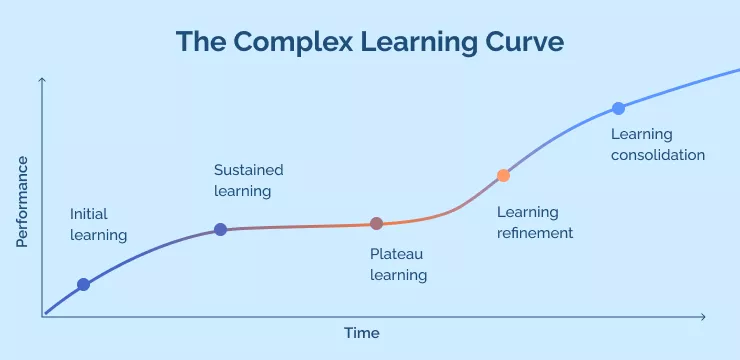
The complex learning curve is more intricate than other learning curves and requires heightened measurables for tracking employee performance. The fundamental principle of the complex learning curve is that employees may experience multiple gains and losses during their learning curve journey.
Employees must be able to identify the root cause of any losses, such as failed tests or mistakes in product development, and adjust their approach accordingly. Becoming proficient in a task may be daunting, and it could take an extended time to become acclimated after training. Hence, regular practice is critical for successful mastery.
The Complex Learning Curve can be broken down into five key stages:
Stage 1: Initial learning entails the first time a person attempts to learn a new skill.
Stage 2: Sustained learning is when the learner begins to retain the skill and adapt its use in various contexts.
Stage 3: Plateau learning is when learners have maximized their knowledge and can no longer improve.
Stage 4: Learning refinement is when the learner refines existing skills, learns to use the skill more efficiently, and finds uses for it in new contexts.
Stage 5: Learning consolidation entails consolidating and mastering all previously acquired skills and knowledge, also known as “overlearning.”
The S-Curve

The S-Curve can be characterized by a gradual, consistent increase in performance until it reaches a peak and subsequently declines. This curve is often associated with developing a new product or process, where employees get used to it before eventually reaching a peak performance level, after which their performance declines.
According to Mckinsey, applying this thinking to the L&D context, however, is a new, innovative, and powerful way to describe cycles of learning and development and link them over time.
The S-Curve is typically used for projects that involve complex changes, such as large-scale digital transformation projects. As such, this curve needs to reflect both the complexity of the change and its expected impact on employees. Change advocates can measure the adoption of new organizational processes and technologies through this curve type.
The Diminishing Returns Curve
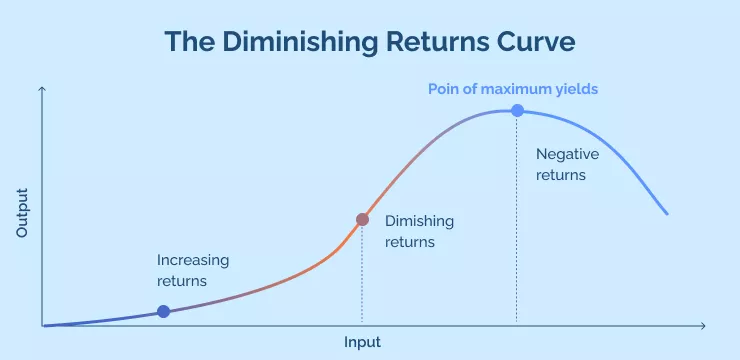
Once a particular production level is reached, the law of diminishing marginal returns states that adding another factor to produce more output will result in even smaller increases. This principle holds true regardless of whether we are talking about labor or capital investment.
Investopedia states that diminishing marginal returns are an effect of increasing input in the short-run, while at least one production variable is kept constant, such as labor or capital.
At the outset of learning, development increases quickly on a diminishing returns curve; however, as more time passes by, progress slows down. This curve is initially steep and then drops off, reflecting the diminishing returns of learning a new skill. This curve is best used for conceptually simple skills but requires much practice to master.
The diminishing returns curve is suitable for curve projects that require significant repetition or practice to master, such as in the case of new software or technology. Change advocates can use this curve to measure skill development and identify areas for improvement if necessary.
A diminishing returns learning curve is observed when learning-by-teaching is used. Learning by teaching involves learners learning through education, and as more learning takes place, the learning curve flattens out, and learning gains become more incremental.
This phenomenon is due to the fact that learning by teaching involves not only learning new knowledge but also practicing what has been learned. Learning gains become less as the learner continually practices, and learning plateaus occur. Therefore, learning by teaching can be effective in learning new material. However, learning gains can become insignificant over time.
The Increasing Returns Curve
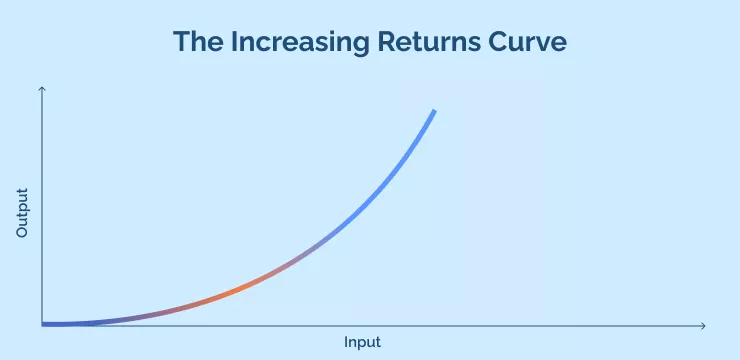
The increasing-returns curve progresses gradually but quickly accelerates over time until mastery is attained. This curve is suitable for skills that require a lot of practice but can be mastered relatively quickly, such as customer service skills. Additionally, the increasing returns curve is ideal for skills that need continuous practice and refinement, such as public speaking, writing, and negotiation.
Change advocates can use this curve to measure the success of a particular skill set or process’s success and identify areas for improvement. The increasing returns curve can also measure employee engagement and satisfaction with a particular process or skill set.
Understanding The Six Learning Curve Phases
Understanding the different phases of the digital learning curve for enhanced organizational change is important for learning-by-teaching approaches. The learning curve has six distinct phases, which we will discuss here.
- Negligible Progress – Learning at this stage is slow due to a lack of familiarity with the new technology or process. Learning strategies like practice drills and refresher sessions -can help employees get past this stage.
- Increasing Gain – Learning at this stage requires more work and commitment from the employee and leadership. This is when employees begin to better understand the new technology, process, or concept. Learning strategies like role-playing and team problem-solving are effective at this stage.
- Decreasing Gain – Learning at this stage is challenging due to the technicality and complexity of the new technology or process. Employees will need additional support from their managers and peers to move past this stage. Learning strategies like shadowing and peer-to-peer mentorship are effective at this stage.
- Learning Curve Plateau – The Learning Curve Plateau is a relatively flat section of the Learning Curve where proficiency is maintained. Learning stagnates during this phase as challenges abate and employees become accustomed to the new process or technology.
- Renewed Gains – Renewed gains occur when the Learning Curve Plateau is surpassed and proficiency increases. Experiencing a sense of pride and dedicating yourself to achieving ever-higher levels of success could be the motivating factor behind these extra accomplishments.
This indicates that employees are actively engaged in their work and have become comfortable with new processes and technology. Learning strategies such as brainstorming sessions and team-building activities can help employees break through the learning plateau stage to reach renewed gains. - Approach To Limit – This final phase of the Learning Curve represents a point of mastery and peak performance. Learning strategies such as mock presentations and feedback sessions can help employees reach this stage.
Additionally, advocates for organizational change should recognize and reward employees who reach this stage. This can motivate other team members to reach their Learning Curve goals.
Alternative Learning Models to Streamline Organizational Change
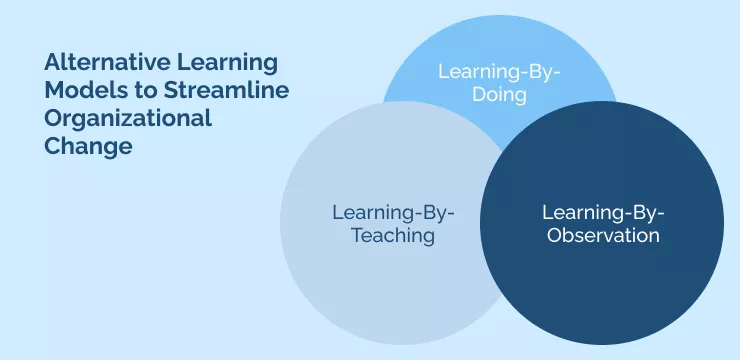
Philosophers John Dewey and Paulo Freire proposed the theory of ‘learning-by-doing,’ which encourages an interactive experience where learners engage with their environment to gain knowledge. This hands-on approach is a powerful tool that can be combined with the practical aspects of curve models since it allows students to adapt quickly and learn more effectively.
This learning model can be broken down into the following three categories:
Learning-By-Doing
Learning-by-doing is an efficient and effective way to learn new skills and involves employees actively engaging in the task, often with instruction and guidance from an experienced mentor or trainer.
Acquiring knowledge through practical experience teaches even the most intricate abilities in conventional and casual instruction scenarios. Learning-by-doing has proven to be one of the most successful learning methods, as participants benefit from direct experience and feedback throughout their learning journey.
This is because learning-by-doing requires employees to apply their learning directly, allowing them to immediately identify the outcome of their actions and understand any mistakes they may be making.
Many businesses have added learning-by-teaching to their learning strategies, which use learning-by-doing as their foundation. It involves employees teaching others what they have learned, allowing them to share their experiences and learn from each other in a collaborative environment.
This method encourages participation and collaboration while providing an effective learning experience for everyone involved.
Learning-By-Teaching
Learning-by-teaching is an effective way to learn and retain new skills and involves employees actively engaging in the task and providing guidance or instruction to others. Learning-by-teaching can be used in formal and informal training environments to facilitate learning and information-sharing.
By learning through teaching, learners can absorb and understand the material more effectively while also learning how to explain complex topics clearly and concisely.
The efficiency curve of learning-by-teaching also flattens as learners become increasingly familiar with the topics they are taught. This can be seen in the case of a student learning a new language. As the student learns more and more words, learning gains start to diminish as learning plateaus are reached.
Ebbinghaus’s aforementioned ” Forgetting Curve ” is a commonly cited learning curve for learning-by-teaching is Ebbinghaus’s aforementioned “Forgetting Curve,” which states that most learning is forgotten within a few weeks or months. This indicates that learning by teaching is not a permanent learning method and requires frequent practice to be effective.
Therefore, learning-by-teaching should be part of an overall learning strategy that includes other learning techniques such as spaced repetition, practice tests, learning curve graphs, and projects. Learning-by-teaching can help pupils understand concepts better as the learning culture expands.
Learning-By-Observation
Learning-by-observation is a method of learning new skills where the employee doesn’t participate in a task. Instead, experienced mentors or trainers demonstrate how to correctly complete a task while the trainee visually observes.
Learning-by-observation is a powerful tool that can be used to educate people in both traditional and informal training settings and has been identified as a practical methodology for teaching employees how to embrace, understand and implement organizational change in the digital era.
Benefits of the Learning Curve
Learning curve models are beneficial because they’re ideal for measuring organizational and employee performance and can provide valuable insights into employee engagement, particularly in large-scale digital transformation projects.
There are various other benefits to adopting a learning curve model, some of which include the following:
- The ability to measure employee skills by highlighting strengths and weaknesses
- The ability to measure the effectiveness and success of organizational processes
- Invigorating the workforce by spawning an atmosphere of continuous education and assessment
- Helping change advocates create more effective and timely interventions to successfully implement organizational change
- Better craft strategic plans that bolster employee performance or elevate a whole department.
Overall, monitoring learning curves helps change advocates comprehend an employee’s growth while mastering a certain assignment, allowing companies to make the necessary improvements to enhance the learning journey. By helping change advocates identify whether a process or skill set is effective using a curve model, they can focus their efforts on improving the process rather than wasting time creating a new one—which can slow learning.
Barriers to the Learning Curve
Learning curves require significant time to develop and track progress; without adequate resources, they can quickly become ineffective and stifle progress. Additionally, a lack of communication between learners and change advocates can confuse and make it difficult to measure progress.
Other common barriers to implementing the learning curve include the following:
- Lack of resources
- Lack of accuracy in predicting future outcomes
- Communication breakdowns
- Lack of training or expertise
- Low levels of motivation or disciplinary problems
- Lack of commitment to the learning process
Other disadvantages of the learning curve model include its lack of flexibility and its dependence on structured, standardized processes. Learning curves can also be difficult to measure if the goals are not clearly defined or if the metrics are not properly tracked. Because time, prior experience, and quality of training all come into play when evaluating a learning curve, analyzing only one of these variables will likely lead to inconclusive results.
Learning Curve Model Applications
Utilizing learning curves is a fundamental way to assess an organization and its employees’ progress. However, there are different methodologies for applying curve models, the predominant methods being qualitative and quantitative measurables.
This means that change advocates must decide whether to measure progress qualitatively, through observations and feedback from learners, or quantitatively, by tracking key performance indicators and metrics.
Let’s differentiate the two:
Qualitative – Opting for a qualitative learning curve implementation would entail the company assessing many factors required for an employee to learn a process or skill set. This typically involves the provision of non-mathematical-measurables, categorical variables, and descriptive judgment, e.g., words, symbols, and meanings.
Quantitative – Alternatively, learning curves can also be quantitative, which sees the company monitor and assesses the employee learning curve using numeric variables. During this process, the company will analyze specific activities, such as the speed and accuracy of work or the time taken to complete a task.
Through quantitative methods, you can precisely measure variables and analyze your assumptions. On the other hand, qualitative approaches enable a more profound look at ideas and experiences.
Change advocates will be required to decide whether qualitative, quantitative, or a combination of both learning curve measurables will need to be utilized in organizational transitions.
How Change Agents Can Implement The Learning Curve For Enhanced Organizational Change
New technology doesn’t disrupt the status quo. Rather, it’s the unpreparedness of business and change leaders to deploy and continuously adapt change management solutions that provide employee guidance alongside the introduction of new processes, technology, or tools.
The curve chart below shows the trajectory of employee productivity in blue and the trajectory of change advocates’ support in pink. The chart reveals that when employee productivity dips, it can soon begin to incline again once the efforts of change advocates are accelerated. As such, change advocates are responsible for launching agile change initiatives that provide consistent employee guidance.
CHART *Can the graphic design team recreate this image in different colors? Yellow = blue, and orange = pink.
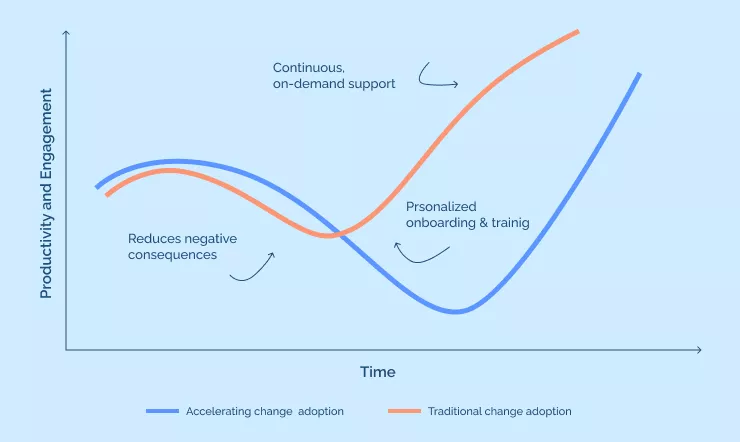
If you are looking to implement the learning curve model to accelerate organizational speed, here are some of the most impactful strategies change advocates can leverage:
- Acknowledge & honor key accomplishments – Recognize and reward employees for their progress, no matter how small. This will help create a sense of accomplishment that encourages continued effort and improvement.
- Uphold clear and transparent communication – Ensure everyone involved in the project is kept up-to-date with continual communication. This will help minimize confusion and ensure everyone is on the same page.
- Encourage collaboration and open dialogue – Invite & foster conversation amongst team members as they learn new skills. This will allow employees to better understand the challenges and collaborate to find solutions.
- Mitigate barriers – Employees can manifest self-destructive behaviors such as anger and resistance during transitional and transformational periods. Change advocates should encourage an open forum for employees to communicate their thoughts freely and without fear of judgment or retribution.
- Provide timely feedback & coaching – Provide support along the way by giving employees specific feedback on their progress. This will help keep employees motivated and ensure they have the tools they need to be successful.
Proven Tactics for Minimizing The Learning Curve
Overall, the Learning and Change Curve models provide a framework for organizations to understand how best to support employees’ learning and how they adapt to new processes or technologies.
Learning strategies such as role-playing, team problem-solving, shadowing, and peer-to-peer mentorship can help employees move more quickly and effectively through the Learning Curve and the Change Curve.
Successful change leaders understand that successfully navigating the learning curve can only be achieved when employees trust the process and feel their issues are being heard. Open communication, empathy, flexibility, and recognition are all essential components of an effective curve implementation.
By understanding how these models work, organizations can create an environment conducive to a sea of positive change.
Transform your company’s performance with these essential tips to leverage the learning curve when creating productive training programs:
Tip 1 – Increase investment in training technology
Companies are starting to recognize the power of employee training software and its ability to offer tailored learning content that can be used to reduce ramp-up time for all employees.
These programs have become essential tools for improving business knowledge acquisition by utilizing sophisticated user analytics. Digital adoption platforms (DAPs) are another great way to maximize the Learning Curve’s efficiency and get employees up-to-speed quickly by providing interactive simulations, concise videos, and other fun activities to make learning more engaging—more on DAPs later.
Tip 2 – Continuously monitor progress
Change advocates should not forgo the learning curve theory. Initial training challenges and change obstacles subside. Using a method of continuous tracking will allow organizations to detect problems as soon as they appear and maintain the strategy beyond a specific window of time. This will enable them to avoid any issues and monitor progress to ensure successful organizational outcomes way into the foreseeable future.
Tip 3 – Invest in personalized and tailored training
Elevate employee engagement, hone training efficacy, and streamline learning curves with customized educational courses tailored to individual job roles and teaching modalities. By personalizing training programs for each team member (both novice and experienced), you can create an environment of both collective and individual progress.
Tip 4 – Establish quantifiable objectives for the near and distant future
Establish tangible and achievable goals to evaluate personnel performance and the success of your training program. By outlining what employees should be able to accomplish after completing their objectives, you can ensure that everyone is on the same page about your program’s goals and purpose.
Tip 5 – Modify approach and alter training methods
If the present training methods do not yield desired results, consider exploring new employee training techniques or tweaking existing ones. Although, adjusting slightly to enhance performance may necessitate testing and refining.
Making minor adjustments to the training program can significantly impact the overall efficacy of your curve implementation. By monitoring employee performance and adjusting when necessary, you can ensure that your program is up-to-date and effective.
Tip 6 – Improve onboarding processes
Onboarding processes can play a significant role in helping employees reach the Learning Curve’s desired end result. Organizations can provide employees with clear procedural information and guidance by utilizing dedicated onboarding programs to fast-track progress, enabling them to become more comfortable in their new roles.
Tip 7 – Seek additional expertise from mentors and thought leaders
Bringing in additional expertise from experienced professionals and thought leaders can help organizations best facilitate effective employee training programs. Mentors and industry experts can provide valuable insight, advice, and expertise on optimizing the implementation of the learning curve.
Digital Adoption Platforms (DAPs): A Solution for Navigating the Digital Learning Curve?
As we’ve discussed, the learning curve can be an invaluable tool for organizations seeking to achieve organizational change in an increasingly digital world. By leveraging the benefits of the right digital adoption platform (DAP) equipped with learning curve principles, organizations can increase their ROI, cut down on training and onboarding costs, and ensure that employees are up to speed quickly.
Digital learning provides organizations and change advocates with comprehensive educational content designed to hone employee skills, create a smooth onboarding process, and equip employees with the knowledge and resources needed to reach digital maturity. Curve models can be combined with instructions from the DAP to quickly and effectively guide employees through the learning curve.
Additionally, DAPs provide a range of features that can be custom-tailored to individual curve objectives and employee roles, such as interactive tutorials, training plans, onboarding assistance, and analytics to track performance. By taking advantage of the learning curve implementation supported by a reliable DAP, organizations can maximize employee capabilities and potentially spark a sea of change.
The Power of Digital Adoption for Organizational Change
Digital adoption is the process of introducing and implementing new technology, products, or services into an organization. It can be further defined as transitioning from working with legacy systems to newer technologies.
Change advocates must carefully consider the learning curve theory when implementing new digital initiatives, as the digital adoption rate can significantly impact organizational change initiatives’ success. With the provision of a digital curve model, organizations can better identify areas of improvement and ensure that employees are provided with the necessary training to adopt and use new technologies effectively.
Digital adoption is an opportunity to transform the way organizations do business. The digital learning curve can be leveraged to assess digital investment returns and make more efficient decisions. Hence, organizational transformation requires long-term commitment and a dedicated team of DX professionals to ensure successful implementation.
Thoughts For The Future
Change advocates should provide employees with support, training, and resources during the learning curve, along with guidance on how to use new tools, systems, and processes.
The Learning Curve Theory shows that with proper training and development, employees can learn and adapt quickly, leading to the successful implementation of changes.
By understanding the learning curve concept, organizations can more accurately plot their course toward successful change initiatives, resulting in efficient use of resources, a successful transition process, and overall organizational performance.
As organizations adjust to digital transformation and pursue lasting organizational success, the Learning Curve Theory must be considered to ensure the successful implementation of change initiatives. With an understanding of this concept and its application in organizational change processes, business and change advocates can better manage their resources and create efficient transition plans for lasting success.
Successfully implementing curve principles requires a strategic and comprehensive approach. To finish—learning curve objectives should be specific, measurable, attainable, relevant, and time-bound.
WalkMe Team
WalkMe spearheaded the Digital Adoption Platform (DAP) for associations to use the maximum capacity of their advanced resources. Utilizing man-made consciousness, AI, and context-oriented direction, WalkMe adds a powerful UI layer to raise the computerized proficiency, everything being equal.



